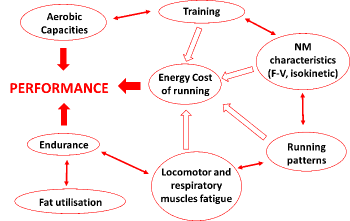PHYSIOLOGICAL AND BIOMECHANICAL DIFFERENCES BETWEEN TRAIL VS ROAD RUNNING
Trainee: Thibault Besson and Frederic Sabater (PhD Students)
Collaborators: Jérémy Rossi (LIBM), Marilyne Berthet, French Athletics Federation.
SCIENTIFIC SUMMARY

Participation in trail running has increased during the last decades. Trail running involves running in more varied terrain than road running. The demands of training and competing for trail-specific conditions may require specific physiological adaptations compared to road running, improving the athlete’s ability to run on hilly terrain. The purpose of the study is to determine the physiological differences elite road vs trail runners in both elite (French national team in trail running and marathon) and non-elite (regional level runners). It was hypothesised that trail runners would have a more force-oriented force-velocity profile (FVP), higher energy cost of running (Cr) on level but lower Cr on uphill, and a greater lower limb maximal strengh compared to road runners. FVP were measured using a two-sprint test on a cycle ergometer and Cr was calculated by measuring the O2 consumption and CO2 production while running at 10 and 14 km/h at 0% slope, and at 10 km/h on a 10% slope on a treadmill. Strength was assessed by measuring isometric maximum voluntary contraction of the knee extensors, knee flexors and hip extensors. Running biomechanics parameters (flight time, contact time and step frequency, leg stiffness were measured.
Key words:performance, trail running, force/velocity profile, power, running biomechanics, running economy, slope.
